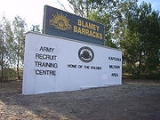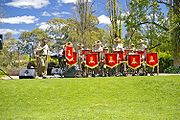
Kapooka
Encyclopedia

Australian Army
The Australian Army is Australia's military land force. It is part of the Australian Defence Force along with the Royal Australian Navy and the Royal Australian Air Force. While the Chief of Defence commands the Australian Defence Force , the Army is commanded by the Chief of Army...
Department of Defence since December 1, 1998 for its Recruit Training Centre situated at Kapooka
Kapooka, New South Wales
Kapooka is a suburb in the south west of Wagga Wagga, New South Wales, Australia.The suburb of Kapooka is home to the Department of Defence's Blamey Barracks from where the Army Recruit Training Centre conducts its operations....
, an outer suburb of Wagga Wagga
Wagga Wagga, New South Wales
Wagga Wagga is a city in New South Wales, Australia. Straddling the Murrumbidgee River, and with an urban population of 46,735 people, Wagga Wagga is the state's largest inland city, as well as an important agricultural, military, and transport hub of Australia...
, in the Riverina
Riverina
The Riverina is an agricultural region of south-western New South Wales , Australia. The Riverina is distinguished from other Australian regions by the combination of flat plains, warm to hot climate and an ample supply of water for irrigation. This combination has allowed the Riverina to develop...
region of New South Wales
New South Wales
New South Wales is a state of :Australia, located in the east of the country. It is bordered by Queensland, Victoria and South Australia to the north, south and west respectively. To the east, the state is bordered by the Tasman Sea, which forms part of the Pacific Ocean. New South Wales...
.
The Army Recruit Training Centre (ARTC) is located within Blamey Barracks, about 9.5 km south-west of Wagga Wagga. Blamey Barracks are named after Field Marshal
Field Marshal (Australia)
Field Marshal is the highest rank of the Australian Army and was created as a direct equivalent of the British military rank of field marshal. A five-star rank, the equivalent ranks in the other armed services are Admiral of the Fleet and Marshal of the Royal Australian Air Force...
Sir Thomas Albert Blamey, GBE
Order of the British Empire
The Most Excellent Order of the British Empire is an order of chivalry established on 4 June 1917 by George V of the United Kingdom. The Order comprises five classes in civil and military divisions...
, KCB
Order of the Bath
The Most Honourable Order of the Bath is a British order of chivalry founded by George I on 18 May 1725. The name derives from the elaborate mediæval ceremony for creating a knight, which involved bathing as one of its elements. The knights so created were known as Knights of the Bath...
, CMG
Order of St Michael and St George
The Most Distinguished Order of Saint Michael and Saint George is an order of chivalry founded on 28 April 1818 by George, Prince Regent, later George IV of the United Kingdom, while he was acting as Prince Regent for his father, George III....
was an Australia
Australia
Australia , officially the Commonwealth of Australia, is a country in the Southern Hemisphere comprising the mainland of the Australian continent, the island of Tasmania, and numerous smaller islands in the Indian and Pacific Oceans. It is the world's sixth-largest country by total area...
n General of the Second World War
World War II
World War II, or the Second World War , was a global conflict lasting from 1939 to 1945, involving most of the world's nations—including all of the great powers—eventually forming two opposing military alliances: the Allies and the Axis...
and the first, and to date only, Australian to attain the rank of Field Marshal
Field Marshal (Australia)
Field Marshal is the highest rank of the Australian Army and was created as a direct equivalent of the British military rank of field marshal. A five-star rank, the equivalent ranks in the other armed services are Admiral of the Fleet and Marshal of the Royal Australian Air Force...
. Blamey was born near Wagga Wagga.
During World War II
The site that was to become ARTC was established on a property on the southern slopes of the Pomingalarna Reserve in 1942 as a direct result of defence needs during World War IIWorld War II
World War II, or the Second World War , was a global conflict lasting from 1939 to 1945, involving most of the world's nations—including all of the great powers—eventually forming two opposing military alliances: the Allies and the Axis...
. As a part of the Royal Australian Engineers Centre thousands of engineers were trained in basic soldiering skills as well as engineering duties. In addition 47,000 regular soldiers also trained at the barracks from 1942 to 1945. The location was also the camp for members of the Australian Women’s Army Service who acted as orderlies, drivers and hospital staff during that period of time.
After World War II
Following the Second World War the barracks became the 1st Recruit Training Battalion (1RTB) which from November 1951, with Lieutenant Colonel V.E. Dowdy appointed as the first Commanding Officer. During 1952 and 1953, 1RTB was joined by 2nd Recruit Training Battalion in temporary buildings on the ridge south of the main camp.Most of the current facilities were constructed during 1965 and 1966 and officially opened on 6 December 1966 by the then Governor of New South Wales, Sir Roden Cutler, VC, KCMG, CBE. 1RTB conducted training for both national service and regular Army recruits, and during the Vietnam War
Vietnam War
The Vietnam War was a Cold War-era military conflict that occurred in Vietnam, Laos, and Cambodia from 1 November 1955 to the fall of Saigon on 30 April 1975. This war followed the First Indochina War and was fought between North Vietnam, supported by its communist allies, and the government of...
between 1965 and 1972, in excess of 10,000 National Service men trained at Kapooka.
Recent history

The centre took on the additional responsibility of training some reserve recruits from 1993.
Reserve recruits undertake a 28 day program whilst the recruits that are to form part of the Australian Regular Army undertake an 80 day program.
The Army Adventurous Training Wing moved from Bonegilla, Victoria
Bonegilla, Victoria
Bonegilla is a bounded rural locality of the City of Wodonga Local Government Area in northeast Victoria, Australia, located 10 kilometres east of Wodonga, and around 300km north-east of Melbourne. At the 2006 census, Bonegilla and surrounding area had a population of 773.- History :Bonegilla Post...
to the Blamey Barracks in 1998. ARTC has two training wings, Recruit Training Wing (RTW) that trains all the regular and reserve recruits for the Army, and the Army Adventurous Training Wing that trains unit adventurous training leaders. The signage leading into the ARTC indicates that the centre is also referred to as the "Home of the Soldier".
ARTC is also home to the Australian Army Band
Australian Army Band Corps
The Australian Army Band Corps is the Australian Army's musical branch. The Corps was formed on 2 August 1968 and provides the Army with musical support and seeks to improve the Army's public image.-See also:* Army Recruit Training Centre...
Kapooka. It provides music for military ceremonies.
In October 2006, Recruit Training Wing formally changed its name back to the 1st Recruit Training Battalion (1RTB)

